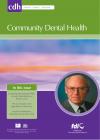Community Dental Health

- Cover Date:
- March 2009
- Print ISSN:
- 0265 539X
- Vol:
- 26
- Issue:
- 1
Caries prevalence and fluoride use in low SES children in Clermont-Ferrand (France)
Objective To evaluate the association between dental caries experience and preventive behaviours of children residing in a deprived area in Clermont-Ferrand (France). Participants and methods All 4-5 yr-olds attending nine schools in deprived areas of the city were invited to participate and 81% (n=282) consented and were examined. Dental caries was recorded at the dentine threshold. Parents completed a questionnaire concerning family demographics and the child’s use of fluoride. Non-parametric tests and logistic regression assessed the relative importance of SES and fluoride variables on dental status (dt>1). Results Fifty four (19%) of the examined children were living in families with an immigrant background, 33% were fully covered by the national health insurance programme for deprived families. Caries experience was high; mean dft was 1.94 (3.31) and 30% of the children had >1 carious teeth. Thirty percent of the families reported using fluoridated salt. Tooth brushing once daily was reported for 39% and twice daily for 26%. Parents declared supervising tooth brushing for 60%. Two thirds of the children, according to their parents, used fluoride supplement between birth and two years. Supervised tooth brushing was significantly correlated with lower mean dt scores. Systemic fluoride use was poorly related to dental caries Immigrant background, family size, type of health insurance and mother’s unemployment were significantly correlated with caries prevalence. In multivariate analysis, immigrant status, supervised tooth brushing and parental knowledge about fluoride in toothpastes were significant caries predictors. Conclusions The majority of low SES children did not practice effective caries prevention; few reported twice daily brushing with fluoride toothpaste. Caries experience was very high and much was untreated. Immigrant status, supervised tooth brushing and parental knowledge about fluoride in toothpastes were significant caries predictors.
Key words : Children, dental caries, fluoride, inequalities, socio-economic status
- Article Price
- £15.00
- Institution Article Price
- £
- Page Start
- 23
- Page End
- 28
- Authors
- S. Tubert-Jeannin, P.J. Riordan, R. Manevy, M.M. Lecuyer, E. Pegon-Machat
Articles from this issue
- Title
- Pg. Start
- Pg. End
- Editorial - Closing the gap in a generation: Health equity through action on the social determinants of health. A Report of the WHO Commission on Social Determinants of Health (CSDH) 2008.
- 2
- 3
- Previous radiographic experience of children referred for dental extractions under general anaesthesia in the UK.
- 29
- 31
- The prevalence of dental caries and fissure sealants in 12 year old children by disadvantaged status in Dublin (Ireland).
- 32
- 37
- Short Communication - Changing dental caries levels in the 1980’s, 1990’s and 2005 among children of a Jerusalem region.
- 62
- 64
